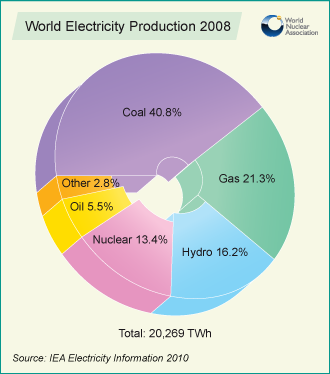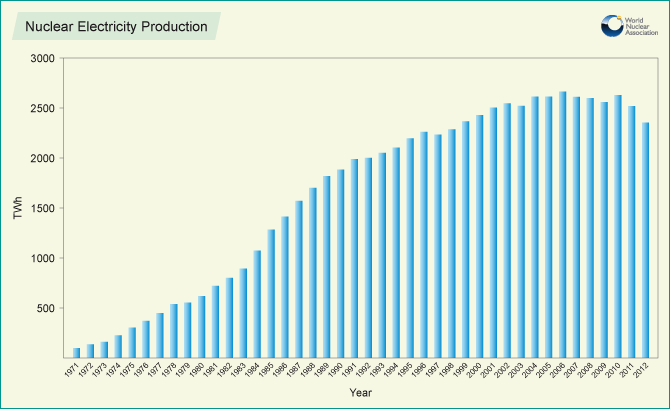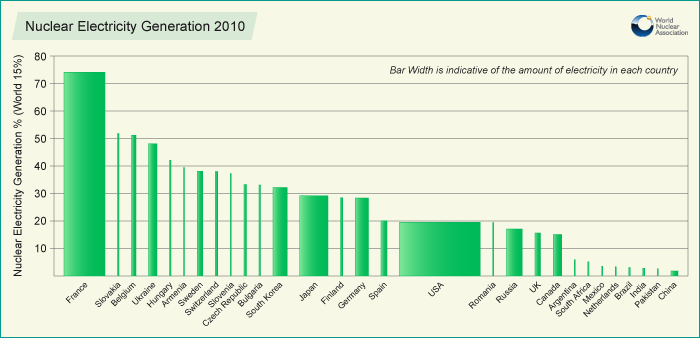Nuclear Power and its Potential in Low-Income Regions
Posted by Kazi Nasir on June 20, 2014
Nuclear power is considered to be an essential energy source of the future – it now accounts for 6% of the world’s total energy production, as well as 14% of the world’s total electricity production. It is quickly becoming a staple of sustainable development as the world tries to replace its dependence on fossil fuels with technologies that produce large quantities of energy (to supply a growing global demand) and do less damage to the environment (i.e., produce minimal greenhouse gas emissions).
 The development of nuclear power technologies began in the early 1930’s with the discovery of the neutron – one of three subatomic particle found in all of the elements (except for Hydrogen). Advancements in research led scientists to theorize that a vast amount of energy could be released by splitting an element in two using a neutron particle (known as nuclear fission). After confirming the theory in 1939, nuclear research progressed at an accelerated rate, perpetuated by both the United States and (the former) USSR’s desire to weaponize the technology. Subsequent research on nuclear energy applications led to the first operational nuclear power plant in 1954. Built in the USSR, it was capable of producing 5 MW of electricity – close to the total output of the University of Ontario’s Institute of Technology’s Combined Heat and Power Plant.
The development of nuclear power technologies began in the early 1930’s with the discovery of the neutron – one of three subatomic particle found in all of the elements (except for Hydrogen). Advancements in research led scientists to theorize that a vast amount of energy could be released by splitting an element in two using a neutron particle (known as nuclear fission). After confirming the theory in 1939, nuclear research progressed at an accelerated rate, perpetuated by both the United States and (the former) USSR’s desire to weaponize the technology. Subsequent research on nuclear energy applications led to the first operational nuclear power plant in 1954. Built in the USSR, it was capable of producing 5 MW of electricity – close to the total output of the University of Ontario’s Institute of Technology’s Combined Heat and Power Plant.
To this day, nuclear power is produced in the same way it was decades ago: neutron particles are shot at a radioactive core at high speeds, which causes Uranium particles (within the core) to split in half, releasing energy and producing more neutrons. These newly-released neutrons react with adjacent Uranium particles and create a chain reaction of Uranium breakdown and energy release.
In recent years, significant progress (both procedural and technological) has been made to ensure minimal risk, as well as maximum efficiency (approximately 90% of the energy released by nuclear fission can now be harnessed to produce electricity), in regards to nuclear power production. Additionally, different reactor designs have been established to ensure nuclear energy can be produced in a wide variety of conditions, for example, despite limitations posed by access to raw materials, high capital costs, radioactive material storage security, etc.

Despite numerous design modifications, an overarching theme in nuclear technology is scalability – reactors have become significantly smaller. This is primarily due to the high capital cost associated with full scale nuclear power plants, as well as a need for more versatile (and less complex) facilities capable of connecting to remote/smaller scale grids – similar to those found in low-income regions. Such nuclear power plants are commonly referred to as Small Modular Reactors (SMRs) and, according to the International Atomic Energy Agency, produce less than 300 MW of electricity.
The importance of SMRs is compounded by the fact that dependable access to high quality, economically feasible, sources of energy is quintessential to a country’s development. In areas where there is slow economic development and poverty runs rampant, energy sources such as coal, oil, or biofuels, often have an unstable supply, volatile prices, and cause detrimental environmental and biological effects. By replacing these primitive energy sources with SMRs, the foundation for progress can be laid, while ensuring investment risk is minimized, by introducing a technology that has a cost-per-megawatt ratio similar to a full scale nuclear power plant at a fraction of the initial cost.

Furthermore, supplementary costs are minimized by not only avoiding the need to build and maintain large scale distribution networks (utility lines, distribution centres, smart grids, etc.), but also by minimizing transmission losses (the energy lost due to limitations on distribution network efficiency). Capital costs can be further reduced by preassembling the SMRs in a high-income country with an established nuclear program and transporting it to low-income countries, thus minimizing on-site construction costs and increasing containment efficiency and radioactive material security. It would also allow low-income countries to reduce the time and ambiguity associated with implementing new nuclear technologies while developing strong international trade relationships which could potentially circumvent the need to locate investment capital (which is significantly harder for low-income countries compared to high-income countries).
SMRs have the potential to characterize the energy profile of low-income countries (in particular, regions isolated from distribution networks) while addressing the main concerns associated with full scale nuclear power plants.
References:
• "Nuclear & Uranium," U.S. Energy Information Administration, 2013. [Online]. Available: http://www.eia.gov/nuclear/data.cfm#nuclear
• "Outline History of Nuclear Energy," World Nuclear Association, 2014. [Online]. Available: http://www.world-nuclear.org/info/Current-and-Future-Generation/Outline-History-of- NUclear-Energy/
• J. R. Lamarsh, Introduction to Nuclear Engineering, 2001.
• "Small Nuclear Power Reactors," World Nuclear Association, 2014. [Online]. Available: http://www.world-nuclear.org/info/Nuclear-Fuel-Cycle/Power-Reactors/Small-Nuclear- Power-Reactors/
Edited from original submission.
Filed under: Students on Sustainability
